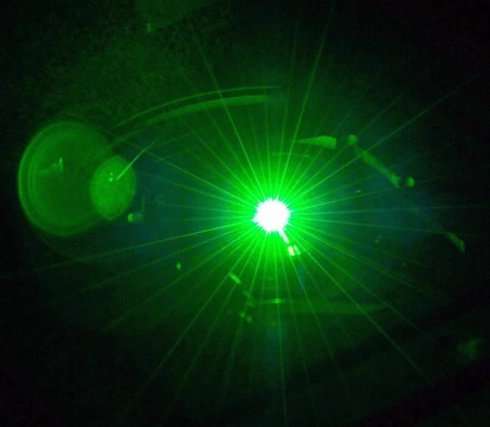Credit: ORNL
Researchers have developed a compact laser that emits light with extreme spectral purity that doesn't change in response to environmental conditions. The new potentially portable laser could benefit a host of scientific applications, improve clocks for global positioning (GPS) systems, advance the detection of gravitational waves in space and be useful for quantum computing.
Researchers from the Massachusetts Institute of Technology's Lincoln Laboratory, USA describe their new laser in Optica, The Optical Society's journal for high impact research.
Even if a laser is designed to emit purely in one wavelength, changes in temperature and other environmental factors often introduce noise that causes the light emission to shift or broaden in frequency. The broadened spectral extent of this emission is known as the laser linewidth. The researchers used a new approach to create an optical fiber laser with a spectral linewidth narrower than ever achieved by a fiber or semiconductor laser. The same laser also provides a method to sense and correct for temperature changes as small as 85 nanoKelvin, or 85 billionths of a degree.
"Today, ultra-low expansion (ULE) cavity lasers exhibit the narrowest linewidth and highest performance, but they are bulky and very sensitive to environmental noise," said William Loh, the paper's first author. "Our goal is to replace ULE lasers with one that could be portable and isn't sensitive to environmental noise."
Achieving narrow linewidth
The researchers developed a laser based on a short loop (~2 meters) of optical fiber configured as a ring resonator. Fiber lasers are compact and rugged and tend to react relatively slowly to environmental changes. The researchers combined the advantages of fiber with a nonlinear optical effect known as Brillouin scattering to achieve a laser with a linewidth of just 20 hertz. For comparison, other fiber lasers can achieve linewidths between 1000 to 10,000 hertz, and off-the-shelf semiconductor lasers typically have a linewidth of around 1 million hertz.
To make the laser extremely stable in the face of long- and short-term environmental changes, the researchers developed a way to reference the laser signal against itself to sense temperature changes. Their method is highly sensitive compared to other approaches for measuring temperature and allows the calculation of a precise correction signal that can be used to bring the laser back to the emission wavelength of the original temperature.
"Temperature is an important contributor to laser noise," said Loh. "A high-quality laser needs to not only have a narrow laser linewidth but also a way to keep that emission stable over the long term."
Improving GPS
This new light source could be used to improve a new generation of optical atomic clocks used for GPS-enabled devices. GPS enables users to pinpoint their location on Earth by triangulating with the signals received from a network of satellites containing advanced atomic clocks. Each satellite provides a time stamp, and the system calculates a location based on the relative differences among those times.
"We think that atomic clocks based on our stable, narrow linewidth laser could be used to more precisely pinpoint the signal's time of arrival, improving the location accuracy of today's GPS systems," said Loh. "The fact that our laser is compact means it could be used aboard satellites."
The laser could also be beneficial for interferometers like the ones used by the Laser Interferometer Gravitational-wave Observatory (LIGO) to detect gravitational waves coming from colliding black holes or collapsing stars. Ultrastable lasers are necessary for this application because laser noise prevents the interferometer from being able to detect the very small perturbations of a gravitational wave.
"There are efforts underway to use lasers in space to create longer interferometer arms for gravitational wave observation," said Loh. "Due to its compact size and robustness, our laser might be a candidate for gravitational wave detection in space."
The researchers say that although their new laser is robust, it is currently a benchtop system suitable for laboratory use. They are now working to develop smaller packaging for the laser and will incorporate smaller optical components to create a portable version that might be as small as a smartphone.
More information: W. Loh, S. Yegnanarayanan, F. O'Donnell, P. W. Juodawlkis, "An Ultra-Narrow Linewidth Brillouin Laser with Nanokelvin Temperature Self-Referencing," Optica, 6, 2, 152 (2019). DOI: 10.1364/OPTICA.6.000152
Journal information: Optica
Provided by Optical Society of America






















